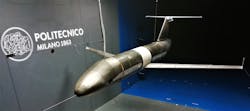Collaboration uses 3D printing to manufacture wind tunnel demonstrators
CRP Technology (Modena, Italy) collaborated with the Politecnico di Milano (PoliMi; Milan, Italy) on the construction of parts for aeroelastic wind tunnel demonstrators.
The Aeroelastic Flutter Suppression project launched by the Department of Aerospace Science and Technology at PoliMi and the University of Washington (Seattle, WA) will test different active control system technologies aiming to attain active flutter suppression. This project focused on technological optimization and experimental validation of gust load alleviation control systems for an advanced green regional aircraft manufactured by Leonardo Aircraft Division.
CRP Technology was involved in manufacturing the external aerodynamic segments of the two wind tunnel demonstrators by using 3D printing (selective laser sintering technology) and carbon-composite Windform XT 2.0.
This material was also used by CRP Technology to create the horizontal aerodynamic features and to enhance the external shape of the wing, while transmitting the aerodynamic loads to the internal structure.
Prior to professional 3D printing, the aerodynamic sections of the wings were produced by carbon or glass fiber fabrics with dry lamination, which were cut to match the wing’s shape. This manufacturing process required much longer times and yielded lower-quality surface finish.
3D printing has revolutionized the entire process of construction and verification of the parts, allowing faster production speed and optimization of the internal shape of these aerodynamic sections to in turn make them as lightweight and stiff as possible. During the test phase, these sections efficiently transmit the aerodynamic forces to the flexible spar, acting as an interface structure between the fluid (incoming air) and the internal structure of the wing. Therefore, it was fundamental that a good surface finish was achieved on the parts exposed to the incoming wind. The components were of reduced weight and were able to transmit the aerodynamic loads on the wing’s longitudinal spar.
For more information, please visit crptechnology.com and windform.com.
